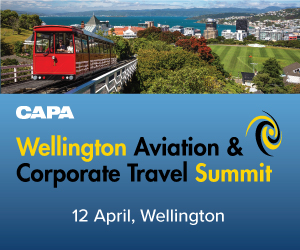Situated just 6km from Wellington city, the capital of New Zealand, Wellington International is the third busiest airport in the nation and a vital piece of the country's aviation network. Its single 2081m runway punches well above its weight, recording traffic growth for the third consecutive year and reaching carriage of 6.1 million passengers in 2017 alone. The airport promises a transformative 2018 - both with the completion of a number of infrastructure projects and the start of new projects.
A regional hub for Air New Zealand, which operated 74.8% of total movements at the airport in the week commencing 26-Mar-2018, Wellington Airport serves 25 destinations with nine airline partners. In 2017 Wellington Airport offered 7.6 million seats and operated an average of 250 daily flights, with over 80% of seats on domestic services.
According to CAPA - Centre for Aviation's airport traffic database, Wellington Airport is becoming increasingly geared to developing international operations, in order to support its already strong domestic presence.
From 2013 to 2018 domestic passengers increased from 4.7 million to 5.2 million, a growth of 10.6%. Over the same period, international passengers have surged from 750,000 to 898,000 - almost double the rate of domestic traffic at 19.6%.
Particularly interesting is that the nationality of international arrivals at Wellington is split almost exactly 50/50 between visitors and New Zealand travellers. Of the overseas share, Australia leads with a majority 36%, followed by Europe with 6%, Asia 3%, North America 2.5%, Pacific Islands 2.5% and other regions with 2%.
Infrastructure:
Wellington Airport CEO Steve Sanderson has referred to 2018 as a "significant year" for the facility, as it nears the completion of a 134 room Rydges hotel and a new multi-level terminal car park. The works will complement expansion of the airport's main terminal, which was completed in 2016.
However, the most anticipated upcoming project is a NZD300 million (USD218 million) expansion of the airport's main runway by 350m - which was previously rejected by authorities due to runway end safety area regulations.
As the airport seeks to gain support for the project, the Wellington City Council has outlined a number of supposed benefits of expansion.
Aiming for completion of works by 2020, the Council expects a bolstered runway would support the ambition to handle Boeing 787 aircraft and allow a direct flight to an Asian economic hub, such as Hong Kong. The airport trialled its first commercial flight with a Boeing 787 in 2011, which showed "clear evidence that it would not be able to fly from Wellington's runway fully laden to Asia", according to the Council.
The council's economic and route development expectations are interesting, to say the least, and seem to function on a "build it and they will come" assumption.
Singapore Airlines already operates 777-200 aircraft at Wellington Airport with its Singapore-Canberra-Wellington route (which will move to a Singapore-Melbourne-Wellington from Apr-2018). A 777-200 could comfortably serve Hong Kong and many other Asian hubs, and Air New Zealand has eight of the aircraft type, according to the CAPA Fleet Database. Considering this information, it is somewhat unsurprising that Air New Zealand seems to oppose a runway extension at Wellington.
Former Air New Zealand group general manager commercial Richard Thomson argues that the length of the runway isn't the problem - instead, it's the size of the local travel market.
"There are simply not enough travellers from the Wellington region or even the lower North Island to sustain regular direct services to any of our long haul destinations; certainly not enough to justify the tremendous investment in infrastructure and the millions of dollars of on-going cost required to support them", Mr Thomson said in a Jul-2016 opinion piece.

